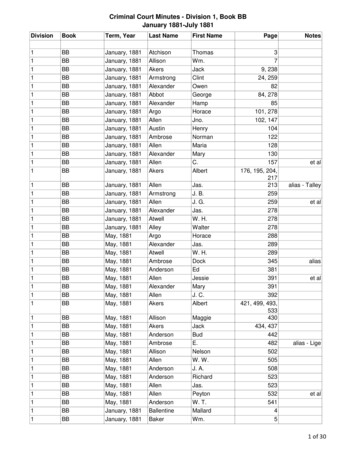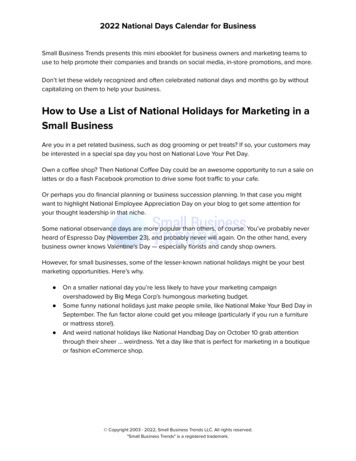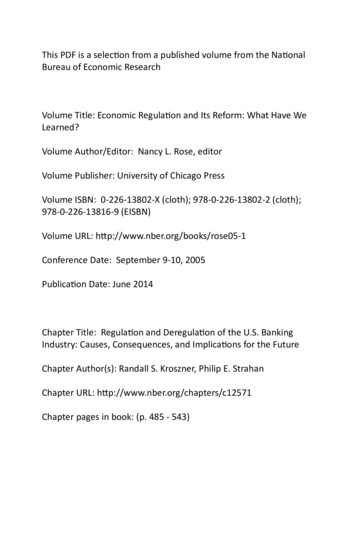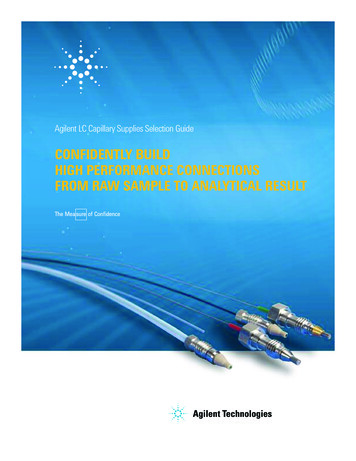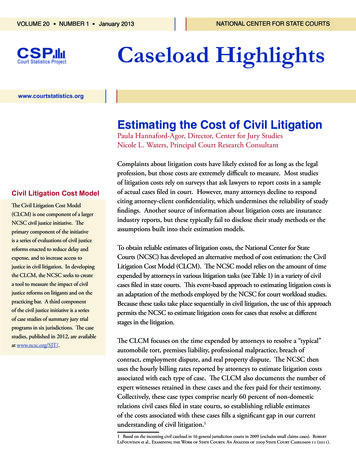
Transcription
VOLUME 20NUMBER 1January 2013NATIONAL CENTER FOR STATE COURTSCaseload Highlightswww.courtstatistics.orgEstimating the Cost of Civil LitigationPaula Hannaford-Agor, Director, Center for Jury StudiesNicole L. Waters, Principal Court Research ConsultantCivil Litigation Cost ModelThe Civil Litigation Cost Model(CLCM) is one component of a largerNCSC civil justice initiative. Theprimary component of the initiativeis a series of evaluations of civil justicereforms enacted to reduce delay andexpense, and to increase access tojustice in civil litigation. In developingthe CLCM, the NCSC seeks to createa tool to measure the impact of civiljustice reforms on litigants and on thepracticing bar. A third componentof the civil justice initiative is a seriesof case studies of summary jury trialprograms in six jurisdictions. The casestudies, published in 2012, are availableat www.ncsc.org/SJT/.Complaints about litigation costs have likely existed for as long as the legalprofession, but those costs are extremely difficult to measure. Most studiesof litigation costs rely on surveys that ask lawyers to report costs in a sampleof actual cases filed in court. However, many attorneys decline to respondciting attorney-client confidentiality, which undermines the reliability of studyfindings. Another source of information about litigation costs are insuranceindustry reports, but these typically fail to disclose their study methods or theassumptions built into their estimation models.To obtain reliable estimates of litigation costs, the National Center for StateCourts (NCSC) has developed an alternative method of cost estimation: the CivilLitigation Cost Model (CLCM). The NCSC model relies on the amount of timeexpended by attorneys in various litigation tasks (see Table 1) in a variety of civilcases filed in state courts. This event-based approach to estimating litigation costs isan adaptation of the methods employed by the NCSC for court workload studies.Because these tasks take place sequentially in civil litigation, the use of this approachpermits the NCSC to estimate litigation costs for cases that resolve at differentstages in the litigation.The CLCM focuses on the time expended by attorneys to resolve a “typical”automobile tort, premises liability, professional malpractice, breach ofcontract, employment dispute, and real property dispute. The NCSC thenuses the hourly billing rates reported by attorneys to estimate litigation costsassociated with each type of case. The CLCM also documents the number ofexpert witnesses retained in these cases and the fees paid for their testimony.Collectively, these case types comprise nearly 60 percent of non-domesticrelations civil cases filed in state courts, so establishing reliable estimatesof the costs associated with these cases fills a significant gap in our currentunderstanding of civil litigation.11 Based on the incoming civil caseload in 16 general jurisdiction courts in 2009 (excludes small claims cases). RobertLaFountain et al., Examining the Work of State Courts: An Analysis of 2009 State Court Caseloads 11 (2011).
www.courtstatistics.orgTable 1: Litigation TasksCase InitiationConduct client intake; initial fact investigation; legal research; draft complaint/answer, crossclaim, counterclaim or third-party claim; motion to dismiss on procedural grounds; defensesto procedural motions; meet and confer regarding case scheduling and discovery.DiscoveryDraft and file mandatory disclosures; draft/answer interrogatories; respond to requests forproduction of documents; identify and consult with experts; review expert reports; identifyand interview non-expert witnesses; depose opponent’s witnesses; prepare for and attendopponent’s depositions; resolve electronically stored information issues; review discovery/case assessment; resolve discovery disputes.SettlementAttend mandatory ADR; settlement negotiations; settlement conferences; draft settlementagreement; draft and file motion to dismiss.Pretrial MotionsLegal research; draft motions in limine; draft motions for summary judgment; answeropponent’s motions; prepare for motion hearings; argue motions.TrialLegal research; prepare witnesses and experts; meet with co-counsel (trial team); preparefor voir dire; motion to sequester; prepare opening and closing statements; prepare fordirect (and cross) examination; prepare jury instructions; propose findings of fact andconclusions of law; propose orders; conduct trial.Post-DispositionConduct post-disposition settlement negotiations; draft motions for rehearing, JNOV,additur, remittitur, enforce judgment; any appeal activity.The CLCM explicitly recognizes that many factors affect the amount of attorney time expended on differentlitigation tasks. Among the more obvious factors are case complexity, client expectations, and the workingrelationship with opposing counsel. In addition, law firms have different internal staffing and training priorities,which affects whether certain tasks are undertaken by senior-level attorneys or delegated to more junior attorneys oreven paralegal staff. Senior-level attorneys are more experienced and may be able to complete tasks more efficientlythan their junior-level colleagues. On the other hand, work performed by senior-level attorneys is invariably billedat higher rates. In the CLCM survey, respondents were asked to estimate the amount of time needed to completelegal tasks for each case type assuming that the case was appropriately staffed in the context of each law firm. Forexample, in a multi-attorney law firm, senior attorneys have a largely supervisory role over the work of more juniorattorneys and paralegal staff in case preparation, but take a more direct role in dispositive litigation tasks such assettlement negotiations and trial. To control for natural variation in case-level time expenditures and billing rates,the CLCM examines quartiles from national estimates to identify the mid-range of “typical” cases. A workingassumption is that exceptionally easy and exceptionally difficult cases will ultimately balance each other out.Two caveats about the CLCM are necessary. First, the NCSC staff that developed the CLCM were surprised by the difficultythat most attorneys, even highly experienced attorneys, encountered when they were asked to visualize a “typical” automobiletort or other type of civil case. While state courts have become more acclimated to employing performance measures toassess both quantitative and qualitative aspects of court operations, it appears that most segments of the practicing civil barapproach legal representation on a case-by-case basis. Consequently, many attorneys who participated in the project found itchallenging to estimate the number of hours involved in drafting a complaint, preparing for and conducting depositions, ortrying a “typical” case even when case scenarios included generalized “facts” to help illustrate case parameters.2
The second issue involved obtaining information about billable hourly rates for senior-level attorneys, junior-levelattorneys and paralegal staff given the wide variety of billing practices in the civil bar. Many firms employ separatebilling rates for in-court versus out-of-court work. Plaintiff lawyers who work primarily or exclusively undercontingency fee agreements often had no basis on which to estimate an hourly rate comparable to the traditional hourlybillable rate. In other law firms, billing may vary based on the client relationship with some work performed on aretainer basis, some work performed at a negotiated discount rate for high volume clients, and some work performedon a pro bono basis. Presumably the financial business model employed by each law firm takes these variations intoaccount when setting compensation for its professional employees such that overall receipts are sufficient to coverroutine direct and overhead expenses regardless of the billing arrangements for individual clients.The ABOTA SurveyThe NCSC pilot tested the CLCM methodology with a sample of experienced civil litigation attorneys in NewHampshire in the fall of 2011. In a focus group setting, those attorneys confirmed that the estimates derived fromthe CLCM were reasonable based on their experience with civil cases filed in the New Hampshire Superior Courts.After making some minor adjustments based on feedback from the working group of New Hampshire attorneysand NCSC colleagues, the NCSC used the CLCM to undertake a national study in cooperation with the AmericanBoard of Trial Advocates (ABOTA).The cooperation of ABOTA offered the NCSC an ideal sample from which to collect data for the CLCM.Founded in 1958, ABOTA is a national organization comprised of experienced attorneys representing bothplaintiffs and defendants in civil litigation. Its mission is to defend the American civil justice system, especiallythe Seventh Amendment right to trial by jury. ABOTA has approximately 6,500 members who are organizedinto 96 state and local chapters in 49 states and the District of Columbia. Qualifications for membership arequite high. Applicants for the lowest tier of membership (Member) must be nominated by an existing ABOTAmember, have completed a minimum of 10 jury trials to verdict as lead counsel, and are expected to achieve thequalifications for Associate level membership within a reasonable period of time. Qualifications for more seniormembership tiers are described in Table 2. In an age in which many lawyers will not try even one case to a juryover their entire careers, the qualifications for ABOTA membership ensure that its membership reflects the mosthighly experienced civil trial attorneys, and presumably the most knowledgeable in the country about the amountof effort involved in litigating these cases.The CLCM survey was disseminated online to the entire ABOTA membership from July 31 through August 31,2012. During that time, 202 ABOTA members submitted complete survey responses and an additional 110 ABOTAmembers submitted partial survey responses with time estimates for one or more of the practice areas. Althoughrespondents practice law in 43 states, over half practiced in California, Texas, or Florida (three of the largest, most activeABOTA statewide chapters, representing 26% of the U.S. population). More than one-third of the respondents wereAdvocate or Diplomate-level members, the two most highly experienced levels of ABOTA.3
www.courtstatistics.orgIn terms of law firm characteristics, half of the respondents work in modest size firms (2 to 10 attorneys) and 13percent were solo practitioners. One-third work in somewhat larger firms (19% in 11 to 25-lawyer firms, 15%in 26 to 100-lawyer firms), and only 3 percent in very large law firms (more than 100 lawyers). The vast majority(82%) of respondents work in general civil practice firms in which lawyers routinely take cases in at least 4 of thepractice areas covered in the survey. Thirty-one respondents practice in boutique firms concentrating on a singlepractice area (21 in professional malpractice; 10 in automobile tort). The 312 respondents collectively reflect theprofessional characteristics of ABOTA’s members.Table 2: ABOTA Membership Levels, Qualifications, andRespondents to the CLCM SurveyMinimum YearsExperienceMinimum Numberof Civil Jury Trialsto dvocateMemberOther**Total8n/a5010*Based on previous ABOTA membership achievedABOTA RespondentsNumberPercent824431210%26%14%* Member level requires a minimum of 10 cases tried to verdict as lead counsel, but the cases do not have to be exclusively civil cases.** Other includes judges, public sector attorneys, and emeritus members.Attorney Time and Costs in Automobile Tort CasesTo illustrate the CLCM methodology, Table 3 presents the quartile breakdown of attorney and paralegal time, prevailingbillable rates, and expert witness fees in a typical automobile tort case. At the 25th percentile, senior and junior attorneyseach spend 2 hours on case initiation tasks while paralegal staff spend one hour for a total of 5 hours of professionaltime. The total amount of professional time engaged in case initiation increases to 12.5 hours at the 50th percentile, ormedian (4.5 and 5 hours, respectively, by senior and junior-level attorneys and 3 hours by paralegal staff), and to 30 hoursat the 75th percentile (10 hours each by senior-level attorneys, junior-level attorneys, and paralegal staff). Dependingon how far through the litigation process the case progresses before it is ultimately resolved, ABOTA respondents reportthat typical automobile tort cases require up to 95.6 hours of professional time at the 25th percentile, 196 hours at the50th percentile, and up to 360.8 hours at the 75th percentile. Billable rates ranged from 200 to 375 per hour forsenior attorneys, 150 to 250 per hour for junior attorneys, and 80 to 110 per hour for paralegal support. If the caseprogressed to the point of retaining an expert witness, which generally takes place during discovery, each side typicallyhires one expert witness at the 25th and 50th percentile, and two expert witnesses at the 75th percentile at a cost of 2,500 to 7,500 per expert.4
Table 3: Hours Expended by Attorneys, Paralegals and Expert Witnesses toComplete Litigation Tasks in Automobile Tort Cases*PercentileSenior 6.015.04.010.0Case 10.0Junior position2.85.010.03.5Subtotal of Time42.875.5135.0x 200 275 20,763Prevailing Hourly RatesBillable Costs 8,550NumberBillable 56.533.378.0135.519.542.590.3 375 150 175 250 80 90 110 50,625 4,988 13,650 33,875 1,560 3,825 9,928Expert Witnesses25th50th75thPercentilePrevailing Fees5.025Paralegal50ththx112 2,500 5,000 7,500 2,500 5,000 15,000*Based on: 255 experienced attorneysAs Table 3 shows, the range of professional time expended on the various litigation tasks for a typical automobiletort case is surprisingly large. The ratio of time expended from the 25th percentile to the 50th percentile to the 75thpercentile appears remarkably stable across each litigation task and for each type of legal professional. The hoursexpended at the 50th percentile are consistently 2 to 2.5 times more than the hours expended at the 25th percentile;at the 75th percentile the number of hours is approximately 4 times more than those at the 25th percentile. Theratios are somewhat larger for junior attorneys and paralegals compared to senior attorneys, but the general patternof doubling the amount of time at the 50th percentile and doubling it again at the 75th percentile remains the same.Applying the hourly billable rates to the time estimates in Table 3 provides estimates of the costs associated with a typicalautomobile tort case. See Figure 1. Cases that resolve shortly after case initiation range from less than 1,000 at the25th percentile to 7,350 at the 75th percentile per side for attorney fees. As the case progresses, those costs continue toaccumulate. A case that settles after discovery is complete through formal settlement negotiations or ADR will range from 5,000 to 36,000 in attorney fees. If the case goes to trial, the total costs including expert witness fees can range from 18,000 to 109,000 per side.2 Based on these estimates, it becomes easy to see how litigation costs might affect a litigant’saccess to the civil justice system. Few litigants would be willing to risk incurring such costs unless the expected return –damages awarded for plaintiffs or damages avoided for defendants – greatly exceed those costs. Most litigants would preferto settle the case well before costs rose to that level. Even attorneys who ordinarily represent plaintiffs under a contingencyfee agreement would naturally evaluate the case based on the likelihood that the resulting fee from the settlement value ofthe case will exceed the expected investment of attorney time and law firm resources before accepting the case.2 Expert witnesses are identified and retained during discovery, but fee agreements generally specify a certain amount or percentage of the fee for drafting a report, participating ina deposition, and testifying at trial. The expert witness expenses reflected in Figure 1 allocate 20 percent of the total expert witness fees to the discovery stage for preparation of anexpert witness report and deposition, and 80 percent to the trial stage for expert testimony at trial. This split is based on reports by trial attorneys of the impact of restrictions onlive expert witness testimony in summary jury trial programs. See Short, Summary & Expedited: The Evolution of Summary Jury Trials (NCSC 2012).5
www.courtstatistics.orgFigure 1: Attorney and Expert Witness Fees by Litigation Stage for Automobile Tort Cases75th Percentile 109,428in thousands 6050th Percentile 43,238 4025th Percentile 17,598 20Total ryInitiateTotal ryInitiateTotal ryInitiate 0Other Types of Civil CasesIn addition to automobile tort cases, the NCSC modeled litigation time and costs for professional malpractice,premises liability, breach of contract, employment dispute, and real estate dispute cases. Detailed tables showingresults for each case type are available at www.ncsc.org/clcm. Table 4 shows the proportion of the total attorneyhours expended on each stage of litigation for these case types at the 50th percentile as well as the total numberof attorney hours that might be expended in a case that progressed all way through trial and post-dispositionproceedings. Across virtually every stage of litigation, professional malpractice cases expend the most amount oflegal time and automobile tort cases expend the least amount of time.Table 4: Proportion of Litigation per Stage (Total Median Hours)Litigation ement8%Trial46%Total AttorneyHours (Median)196Post-disposition69%ContractEmployment 1828439%3677%6%39%42%3744727%
For all case types, a trial is the single most time-intensive stage of litigation, encompassing between one-third andone-half of total litigation time in cases that progress all the way through trial. Discovery is the second most timeintensive stage, encompassing between one-fifth and one-quarter of total attorney hours. The remaining litigationstages each required less than 15 percent of total attorney time. Current civil justice reform efforts often focus onreducing the amount of time expended on trial and discovery tasks during litigation. To be effective, these effortsmust not only decrease the amount of time involved in these litigation stages, but do so without shifting that timeto other litigation tasks. Successful civil justice reform along these lines would not only reduce the litigation costsassociated with each case type (see Figure 2), but may also reduce the time to disposition, providing litigants withspeedier, as well as less expensive, justice.Figure 2: Median Costs of Litigation by Case TypeMalpractice 122kEmployment 88kin thousands 75 60 45Contract 91kReal Property 66kPremises Liability 54kAutomobile 43k 30 positionTotal DispositionTotal DispositionTotal DispositionTotal DispositionTotal DispositionTotal Costs 0Future uses of the CLCMThe NCSC plans to conduct further testing with experienced lawyers to confirm the reliability of the cost estimates and tofurther differentiate factors that affect the model. The NCSC will also continue surveying highly experienced attorneys toadjust these national estimates for state and local jurisdictions. The results of these highly focused surveys will provide benchand bar leaders with tools (1) to conduct local assessments; (2) to focus civil justice reform efforts on litigation stages thatrequire more attorney time ; and (3) to assess the impact of those reforms on access to justice.7
PRESIDENTMary IVISIONCampbellMcQueenThomas M. ClarkeVICE PRESIDENT, RESEARCH DIVISIONThomas M. ClarkeCOURT STATISTICS PROJECT STAFFNational Centerfor State Courts300 Newport AvenueWilliamsburg, Va 23185-4147DIRECTORCOURT STATISTICS PROJECT STAFFRDIRECTORSENIOR COURTRESEARCHANALYSTSRichardY. SchaufflerRobert C. LaFountainSENIOR COURT RESEARCH ANALYSTSShaunaM. StricklandRobertC. LaFountainCOURTRESEARCHANALYSTSShauna M. StricklandChantal G. BromageSarah A.A. HoltGibsonKathrynAshley N. MasonPROGRAM SPECIALISTWilliam E. RafteryCOURT RESEARCH ANALYSTBrenda G. OttoPROGRAM SPECIALISTINFORMATION DESIGNBrenda G. OttoNeal B. Kauder,INFORMATION Inc.DESIGNVisualResearch,Neal B. Kauder,VisualResearch, Inc.This project was supported byGrant No. 2011-BJ-CX-K062awardedof HEREINJusticePOINTSbyOF theVIEWBureauEXPRESSEDARE Statistics,THOSE OF THEAUTHORSANDOfficeof JusticeDO NOT NECESSARILYREPRESENT THEPrograms,U.S. DepartmentofOFFICIAL POSITION OR POLICIES OFJustice. Points of view in thisTHE BUREAU OF JUSTICE STATISTICSdocumentare thoseof theauthorOR THE OFFICEOF JUSTICEPROGRAMS.and do not necessarily representthe official position or policies ofthe U.S. Department of Justice.www.courtstatistics.orgRESEARCH DIVISION800.616.6109Court Statistics ProjectSince 1975, the Court Statistics Project(CSP) has provided a comprehensiveanalysis of the work of state courts bygathering caseload data and creatingmeaningful comparisons for identifyingtrends, comparing caseloads, andhighlighting policy issues. The CSPis supported by the Bureau of JusticeStatistics and obtains policy directionfrom the Conference of State CourtAdministrators. A complete annualanalysis of the work of the state trialand appellate courts will be found inExamining the Work: An Analysis of 2010State Court Caseloads.8Visit the CSP Website atwww.courtstatisticts.orgNonprofitU.S PostagePAIDRichmond, VaPermit No. 9
The CLCM focuses on the time expended by attorneys to resolve a "typical" automobile tort, premises liability, professional malpractice, breach of contract, employment dispute, and real property dispute. The NCSC then uses the hourly billing rates reported by attorneys to estimate litigation costs associated with each type of case.

